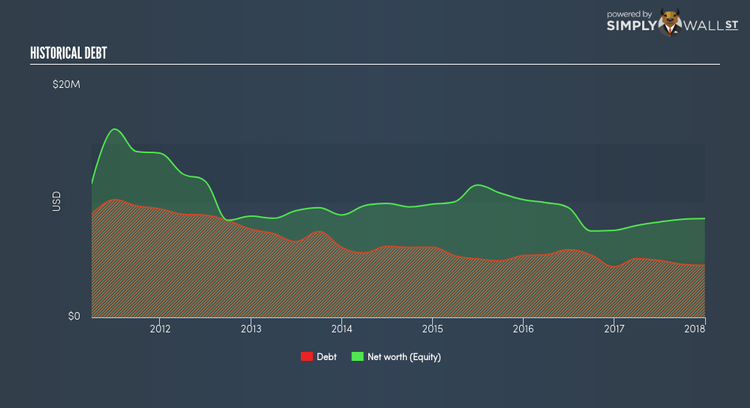What Investors Should Know About Bioanalytical Systems Inc’s (NASDAQ:BASI) Financial Strength

Bioanalytical Systems Inc (NASDAQ:BASI) is a small-cap stock with a market capitalization of US$13.36M. While investors primarily focus on the growth potential and competitive landscape of the small-cap companies, they end up ignoring a key aspect, which could be the biggest threat to its existence: its financial health. Why is it important? Companies operating in the Life Sciences industry, even ones that are profitable, are inclined towards being higher risk. Evaluating financial health as part of your investment thesis is vital. I believe these basic checks tell most of the story you need to know. Though, given that I have not delve into the company-specifics, I’d encourage you to dig deeper yourself into BASI here.
Does BASI generate enough cash through operations?
BASI has shrunken its total debt levels in the last twelve months, from US$5.37M to US$4.58M – this includes both the current and long-term debt. With this debt repayment, BASI’s cash and short-term investments stands at US$434.00K for investing into the business. Moreover, BASI has produced cash from operations of US$1.24M over the same time period, resulting in an operating cash to total debt ratio of 26.99%, meaning that BASI’s current level of operating cash is high enough to cover debt. This ratio can also be interpreted as a measure of efficiency as an alternative to return on assets. In BASI’s case, it is able to generate 0.27x cash from its debt capital.
Can BASI meet its short-term obligations with the cash in hand?
With current liabilities at US$7.72M, it appears that the company is not able to meet these obligations given the level of current assets of US$5.31M, with a current ratio of 0.69x below the prudent level of 3x.
Can BASI service its debt comfortably?
With debt reaching 52.72% of equity, BASI may be thought of as relatively highly levered. This is not uncommon for a small-cap company given that debt tends to be lower-cost and at times, more accessible. We can test if BASI’s debt levels are sustainable by measuring interest payments against earnings of a company. Ideally, earnings before interest and tax (EBIT) should cover net interest by at least three times. For BASI, the ratio of 3.4x suggests that interest is appropriately covered, which means that lenders may be less hesitant to lend out more funding as BASI’s high interest coverage is seen as responsible and safe practice.
Next Steps:
BASI’s high cash coverage means that, although its debt levels are high, the company is able to utilise its borrowings efficiently in order to generate cash flow. But, its lack of liquidity raises questions over current asset management practices for the small-cap. This is only a rough assessment of financial health, and I’m sure BASI has company-specific issues impacting its capital structure decisions. I suggest you continue to research Bioanalytical Systems to get a more holistic view of the stock by looking at the areas below. Just a heads up – to access some parts of the Simply Wall St research tool you might be asked to create a free account, but it takes just one click and the information they provide is definitely worth it in my opinion.
1. Valuation: What is BASI worth today? Is the stock undervalued, even when its growth outlook is factored into its intrinsic value? The intrinsic value infographic in this free research report helps visualize whether BASI is currently mispriced by the market.
2. Historical Performance: What has BASI’s returns been like over the past? Go into more detail in the past track record analysis and take a look at the free visual representations of BASI’s historicals for more clarity.
3. Other High-Performing Stocks: Are there other stocks that provide better prospects with proven track records? Explore a free list of these great stocks here.
To help readers see pass the short term volatility of the financial market, we aim to bring you a long-term focused research analysis purely driven by fundamental data. Note that our analysis does not factor in the latest price sensitive company announcements.
The author is an independent contributor and at the time of publication had no position in the stocks mentioned.

